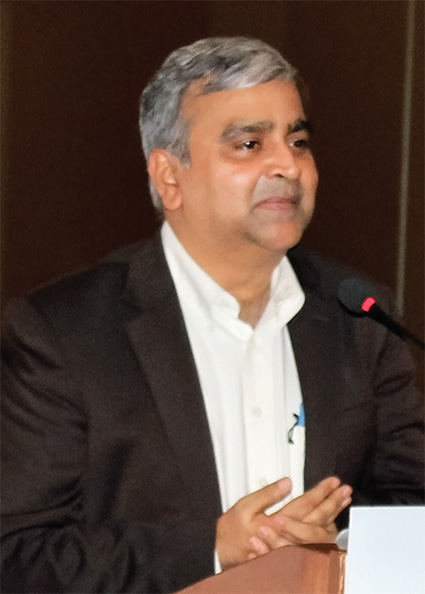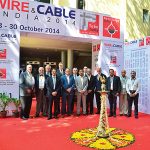On October 29, 2014, Indore Composite, under the stewardship of its CEO Mr. Mukesh Sanghvi, organized a conclave-Cable Industry Meet 2014- for cable industry inviting discussions on myriad of themes related to the growth of the industry. With government all geared to catapult India on the broadband highway, the wire and cable industry seems agile in grabbing the message of its own growth enveloped in various state initiatives.
The conclave witnessed participants ruminating over the themes such as changing India, the scope for cable industry in new growth optimism, the role of broadband in the growth of cable industry, the integrated approach of entire wire and cable industry to harness the upcoming growth, leveraging existing infrastructure to further the growth ambitions, etc.
Representatives from almost all the verticals of wire and cable industry were seen present at the forum. The conclave witnessed many speakers delineating on industry pertinent issues including Mr. Vallabh Bhanshali (Chairman- Enam Securities and Investments), Mr. Badri Gomatam, Chief Technical Officer, Sterlite Technologies, Mr. Naveen Gupta (G.M. Operation & Maintenance- Reliance Jio lnfocomm.), Dr. B.P Singh (Exec. Engineer Telecomm.-Maharashtra State Electricity Transmission Company Ltd.).

Collaborate and Grow Together
Addressing the meet with his inaugural note, Mr. Mukesh Sanghvi said, “I am happy to see many familiar faces, and even happier to see unfamiliar faces, who are all here for the common goal of the growth of cable industry. Indian telecom industry is poised for an exponential growth in next six to eight years. With various projects like NOFN, NFS, 4G, power infrastructure requirements, I am very optimistic about the growth in Indian wire and cable industry. We all need to come together to take the best of this opportunity, which is provided to us, to the cable industry.
“Unlike many progressive countries, India does not have a platform as such where all of us can come together and exchange ideas take things forward helping the growth of the industry. I have been discussing the issue with people in the industry for past two three years about having a platform to meet, interact, and build relationships. Today, Indore is honored to facilitate the first cable industry meet, and hope that in future, many more companies will come forward to make this event even a bigger success. It is satisfying to see representative of telcos, cable TV MSOs, cable manufacturers, composite manufacturers, raw material suppliers, solution providers; and that too on such a short notice.”
India: Poised for Change

Mr. Vallabh Bhansali began his speech by congratulating Mr. Mukesh Sanghvi for the wonderful initiative bringing various streams together. Underlining the reasons for choosing “Is India Poised to Change Dramatically?” theme, he pointed to the momentous time the country is witnessing now which he can see through the prism of 40 years of experience in various industries donning various roles. He said, “I can see so many company’s representatives here known to me for 20-30 years and I’m privileged to play an important role, sometimes crucial, in their growth and development. I’ve also been asked by the government to play a small advisory role in areas such as power, coal, and whole cluster of such industries. But, all that’s less important. What is more important is where we stand today in times. And, that’s the reason of choosing the theme to answer this very pertinent question.”
He tried to explain the persistent lack of conviction amongst Indians on the question of self reliance and change. He emphasized the need to be confidant of the self and leverage the opportunity to see real change in India. He said, “I have seen defeatist attitude amongst Indians in general. While we talk big, somewhere in the heart, we are convinced that nothing will change. Because our history has been one step forward, then one step backward, if not two. Despite of having come along way, we always complain that China is ahead of us. But things are changing, in fact, have changed. “
To drive his point home, Mr. Bhansali cited many examples by taking trips down memory lane of his long, experienced career. Through these instances, he proved the changes taking place and appealed the industry companions to notice the same and surge ahead with positive approach. He stated, “Only 30 years ago, we were all used to either Ambassador or Fiat. When I started my research company in 1982, I remember writing a research report that Maruti will not succeed. We have all been skeptical about its success because of doubts over its light weight, foreign exchange problems, investment problems, etc. But, the success of Maruti is history in itself.
“I think we are at a time when so many things are changing and we can’t notice them; and many more such changes will take place. Yesterday, I was talking to a delegation from Aberdeen-one of the largest FIIs investors in India. I have been discussing some of the things with them that I am discussing here. I am surprised to see their perception of changes taking place in India. May be, because they are global investors, they can see the change better than us. That’s part of their job and that’s why they exist. Nevertheless, we should gain lessons from them.”
The speech, throughout, exuded Mr. Bhansali’s ardent faith in the new leadership at the centre. He enumerated many instances and initiative of the new government under Mr. Narendra Modi ushering the nation towards the perceptible change. Jan Dhan Yojna, Swachha Bharat Mission, disciplining of bureaucracy, and such other initiatives appeared consistently in his speech. On Jan Dhan Yojna he said, “Modi ji believes that every citizen of the country is a master and unless you cater to these masters things won’t change. Jan Dhan scheme started with a target of 50 million accounts over a period of three years which was successively revised to 100 million accounts by Jan. 26, 2015. By Aug. 15, the banks have already opened 55 million accounts. The message to banks, mostly nationalized, was clear that citizens are masters. Moreover, according to an estimate, Rs. 100,000 crores will be in deposits with banks from small contributions from people. Subsidies may also be directed directly to the person with an account in the bank.
“The new government’s Clean India Mission has attempted to create a committed citizenry. I have been talking to people on street about how they feel about ‘Swachha Bharat’ and I’m yet to come across anybody who does not feel ashamed of not contributing to cleanliness around. That’s the change.
“The change in bureaucratic attitude is another change. The government has not only made them disciplined by necessary marking of attendance, but also provided immunity to them from arbitrary orders of incumbent ministers by authorizing to accept only written orders. That’s a big change.”
Mr. Bhansali said that things are changing under the new government and a united India is evolving. He also noted the amount of interests people and corporate are showing in starting foundations and supporting the state’s initiatives. He said, “I was present at Sterlite’s London program, where Mr. Anil Agarwal made the statement that 75 percent of his wealth is for charity.
“Today, more and more people are wishing to work for the government by staking their established careers. Recently, a World Bank professional, whom I was talking with during some meet, said that enough of working with WB and expressed his willingness to aid the government by his skills.”
Mr. Bhansali sounded happy about being helped by circumstances such as falling of oil and falling of commodity prices. Wire and cable industry acts as connecting agents and the government is giving due importance to the industry in creating a digital backbone for the country. He remarked, “One of the most successful shows India hosts-India Plasts was shifted to GIFT city from Delhi. Mr. Modi said that he wanted to demonstrate the world that India got connected.”
He concluded his speech by saying, “As a nation, we can’t move forward unless we undo the history of being defeatist and slavish, and start believing in the self. Now is the time to really believe in bringing about the change. I hope this little conclave does its bit by coming together and having some serious deliberations. I believe ‘India can change dramatically’.”
Treading on Broadband Highway

Mr. Badri Gomatam, Chief Technical Officer, Sterlite Technologies held the dais wherein he turned the spotlight on broadband as a utility to fire the growth boosters of cable industry. He came up with a nice presentation tipped with data and analyses telling how the broadband is sure to unlock plethora of economic potentials to the cable industry. Mr. Gomatam posed relevant questions such as what we mean by broadband; what we can and must do as an industry to shape the broadband policy. He also emphasized the need to change the definition and perception of broadband in the country. The terms in vogue like ‘Internet of Things (IoT)’ and ‘Internet of Everything (IoE)’ are not only jargon, but are media to generate or unlock big economic values according to Mr. Gomatam. He also added that through helping build a great broadband infrastructure, the cable industry will not only profit, but also it will create the durable national assets.
Explaining the economic potentials of the internet, Mr. Gomatam said, “One of the analyses says almost USD 19 trillion may be extracted from the growth in the internet. This analysis may be wrong; but even if this wrong by a factor of 10 i.e. USD 1.9 trillion, the rest is still not bad. And, that’s the potential sitting before industry in India through supplying polypropylene sheets, PPT, and glass fibers.”
“We are living in a mobile world bound by internet and that has to be facilitated by wire and cable industry. Broadband is high speed, high capacity data transmission which is delivered through media like optical, wireless, and copper,” said Mr. Gomatam.
About the need to change the definition of broadband in India, he said, “The definition is long worded. If we pick one number from this definition, the broadband is defined as a national standard data speed of 512kbps which needs to be changed quickly.”
He cited a study by Ericsson and added, “According to the study, increasing download speeds from a weak 0.5 megabits per second to a basic 4Mbps makes a statistically significant difference to a family’s earnings. This study is significant for low income counties like Brazil, China, and India where the need to revise the data speed is imminent.”
He further said, “As the previous speaker said, it’s great time for industries. All of us are very optimistic in just hearing that someone in a very high position uses what was considered 3-5 years ago a nascent technology. Many even questioned the utility of 140 characters as message. But, all that’s history and Twitter is a big deal today. It’s quite encouraging that someone in that very high position uses it. It’s all creation of optical fiber network. It’s a message for us to take the broadband seriously.”
The broadband is slated to take the next quantum leap in India and the government is supporting this movement by cogent policy measures here and there. Speaking on the aspect, Mr. Gomatam stated, “From the government standpoint, there are a lot of positive signs which we should capitalize and take it forward. A number of initiatives have been announced and the initiatives such as Digital India, Broadband Highway, NOFN, etc. are sure to transform India into an empowered society. The policies are articulate, but as an industry we have to take them forward.”
The initiative ‘Broadband Highways’ is sure to deliver a quantum of opportunities to the wire and cable industries. Mr. Gomatam threw some light on the term ‘Broadband Highway’ as to what constitutes it. He said, “This initiative comprises, within it, the universal access to phones, public internet access, e-governance, electronic delivery of services, etc. This is where we, as a wire and cable industry, can play a very important role. Moreover, the expansion of 3G network, community access TV and the 4G network also will create profound opportunities for us.”
On the question where we are in relation to our nearest neighbors as an economy as far as broadband is concerned, Mr Gomatam said, “According to one study, India is at position 118 with respect to data speed in global raking. You may choose not to believe it; but if there is some factor of truth to it, we should be looking to move forward.
“Moreover, regarding penetration, only 30 percent of household is connected through broadband out of which merely 15-20 percent is actually using it. So, nothing to brag about; there is a long way to go. This also means a good sign for the industry to grow.”
There is a concept of utility attached to broadband. Developed countries like America and others have fostered a strong sense of utility orientation to broadband. Like fuel, electricity, and water, broadband is increasingly accepted as the basic utility to unleash much economic value in coming times. Everyone is convinced of vitality of connectivity to all emerging socio-economic structure.
Mr. Gomatam expounded on this utility concept of broadband by stating, “Over the last seven hundred years, three utilities have been found essential viz. fuel, electricity, and water. In our country, electricity is accessible to 88 percent of population, water is in high seventies, but reach to clean burning fuel is very low. In this regard, broadband as fourth utility may have very profound impact on the integrated dissemination of prior three. At least developed countries think so. As already mentioned that connectivity begets economic values; in the manner that it is connected to other utilities.
“The developed countries have understood this fact borne by some of their statements aiming at standardization of broadband. For example, in US, we frequently come across strap lines such as ‘hundred million homes at 100 mbps broadband speed’, ‘fastest mobile network’, ‘affordable broadband’, ‘community access at 1 GB’, etc. These slogans indicate the commitment towards making high speed broadband an essential fourth utility. In India, we will have to affect the same kind of internet initiatives.
“The strengthening of broadband network and speed also cooperates with the idea of clean energy. Optical fiber saves immense energy as compared to previous generation copper wire. Moreover, the coordination of all real-time activities via internet rescues significant volumes of energy that may be drained into actually carrying out these activities.”
The utility concept of broadband is well established in other countries. However, real challenge before India is to imbibe the same and strive hard to actualize it through concerted efforts, viable policy initiatives, and reuse of the existing infrastructure to give initial push. India has comprehensive road and railways network. The initial step should be building optical fiber network along the existing infrastructure.
On this aspect Mr. Gomatam said, “We have very extensive network of road and railways, 43,00,000 km and 115,000 km respectively. To start with, why not build the optical fiber network along this network? We may also use some kind of unified cable designed to serve multiple users with shared access. In addition, we have 300 million homes waiting to be connected. These are the ready pointers for us to have a great start by leveraging the existing infrastructure to create what we wish to.”
“The government initiatives would create the additional momentum to this move of building a world class internet infrastructure. The National Optical Fiber Network (NOFN), Digital India, Broadband Highway, Smart City, etc. are sure to give the much needed surge to broadband revolution in the country where the role of cable industry would be indispensable. All this poised initiatives would be a cause to an exponential growth of wire and cable industry,” concluded Mr. Gomatam.




